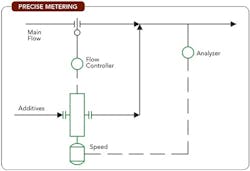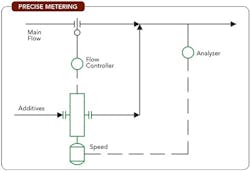Tame Tough Dosing Duties
Precise dosing of liquid additives is essential in a variety of processes. A recent column discussed issues in selecting an appropriate metering pump (“Prevent Metering Pump Mayhem.”). Now, let’s look at the metering pump’s control system, which regulates the amount of additive used. Such systems usually are either open-loop or closed-loop.
[pullquote]
Open-loop systems set the dosing rate based on a measurement upstream of the additive injection point — for example, adjusting it according to the flow rate of the main stream before dosing. This is a reasonable approach where the composition of both the main stream and additive don’t change.
Closed-loop systems set the dosing rate based on a measurement downstream of the additive injection point — for example, adjusting it to meet a desired end target (e.g., for composition, pH or other property). This approach works well for systems that have relatively constant feed rate but some variation in composition. However, significant rate changes can cause dramatic swings in downstream concentration until the feedback controller catches up.
[javascriptSnippet ]
Some systems don’t work well with either control approach. Problems particularly can arise in systems:
• where precise additive concentration is required — e.g., catalyst addition systems with very low additive/stream ratios (1/100,000 or less is common);
• with both large composition and rate changes; and
• with analyzers that have extremely long response times.
Where precise metering is required, one option is to use an additive with a very low concentration of active ingredient. Because additive volume consists of mostly inert carrier, errors in flow rate control of the additive are much less important. However, this approach calls for a bigger and more-expensive additive pump. Also, it doesn’t help with composition and rate changes or analyzers with long response times.
An alternative combines both open-loop and closed-loop control (Figure 1). The open-loop uses feedforward from a flow controller to set the metering pump. The closed-loop uses feedback from a composition analyzer to regulate motor speed. This system separately adjusts for rate and composition variations.
Figure 1. Combining open-loop and closed-loop approaches can enable accurate dosing.
Each loop could have a separate gain and lag built in. This results in a system capable of much more precise control and smaller variations in additive content.
The rapid response to rate changes reduces the effect of the analyzer’s long response times to composition changes. The analyzer only serves to compensate for composition disturbances. Therefore, rate changes take effect immediately, not with a long delay.
Other configurations also are possible — for example, using temperature to change a catalyst addition rate. As reaction rate varies, the catalyst addition would go up or down. Depending upon the reaction order, this control could be more complex. However, implementing non-linear response functions to control motor speed on modern control systems is relatively easy.
Multivariable controllers could meet the same objectives. Nevertheless, the single-input single-output (SISO) configuration does have advantages. It is easier to maintain and less complicated. Operators (and engineers) will find predicting and anticipating responses much simpler with the straightforward system shown in Figure 1.


